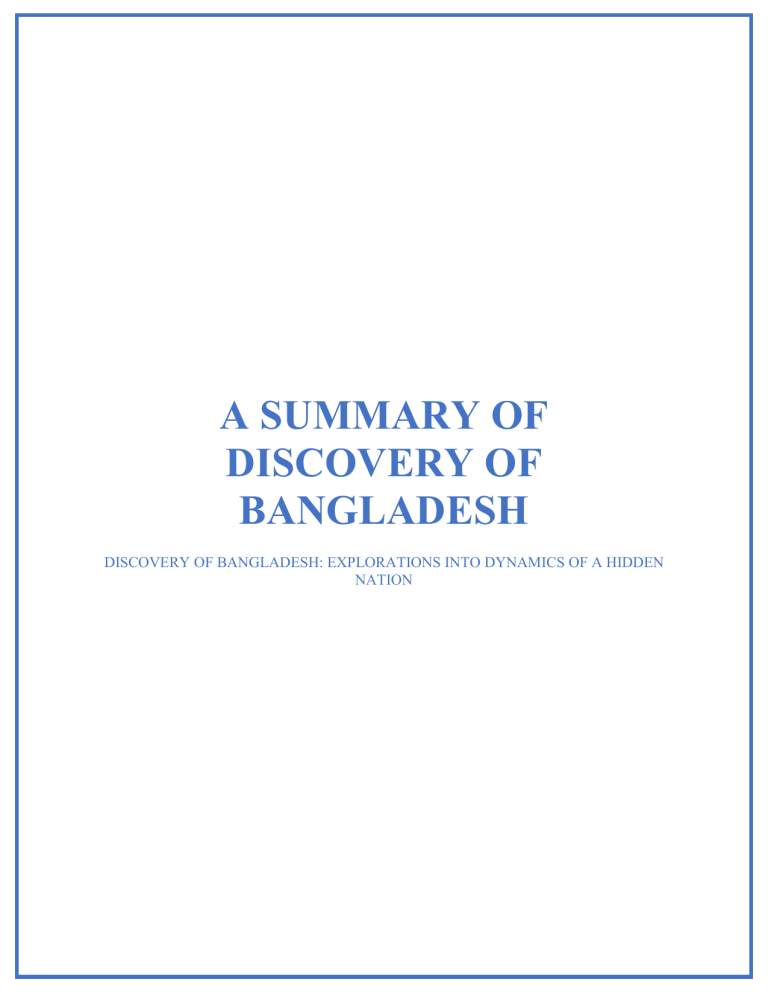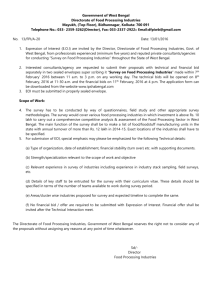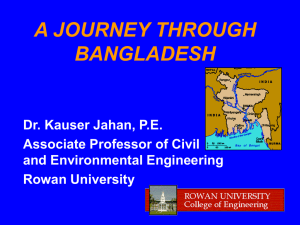
A SUMMARY OF DISCOVERY OF BANGLADESH DISCOVERY OF BANGLADESH: EXPLORATIONS INTO DYNAMICS OF A HIDDEN NATION A SUMMARY OF DISCOVERY OF BANGLADESH Course: Bangladesh Studies (K202) Submitted to Md. Mosta Gausul Haque, PMP Adjunct Faculty Institute of Business Administration University of Dhaka Submitted by Raiad Rafi Batch: 26, Section: A Roll: BEH-97 Institute of Business Administration University of Dhaka Date: 14th February, 2020 Chapter 1: Anatomy of Rural Settlements The key to understanding of society in Bangladesh lies in proper appreciation of the dynamics of her rural settlements. Unfortunately, the received doctrines on rural society in Bengal zone is based not on independent investigations on the nature and structure of rural settlements but on perceptions and preconceptions of generations of scholars on Indian village communities. The rural settlements in Bengal are, assumed to be indistinguishable from the village communities in South Asian subcontinent. This assumption is not only wrong but also misleading. It has precluded an understanding of the dynamics of social life in this region. Except the decade 1941-51, there was a steady increase of population during the period 18911991 whereas total number of villages fluctuated. The fluctuations in the number of villages cannot be explained by the variation in total area. There are three concepts of village in Bangladesh; viz., the survey village or the mauza, the 'local village and the census village. A mauza is an artificial unit which was defined for the purpose of cadastral survey. In most districts of Bangladesh, a mauza comprises a block of land which can be conveniently surveyed. In order to test the reliability of data on villages in the recent censuses, the relationship between the percentage change in the number of villages in a district with the percentage change in population and percentage change in the total area of the district may be examined. Period 1951-61 Correlation between the % change in number of villages and the % change of population in a district 0.147 Correlation between the % change in number of villages and the % of the area of a district 0.072 (0.57) (0.28) -0.292 0.135 (1.18) (0.52) 0.412 - (1.75) (0.00) 1961-74 1974-81 (Bracketed number shows I statistics). Source: Khan, 1987. The first census of Bengal in 1872 resulted in a systematic survey of rural institutions in this province. The census report of 1871 clearly indicates that the degree of corporateness of village institutions diminished as one moved from the west to the east. He concluded as follows: "Villages in Bengal proper are scattered about to a degree unknown in northern India and there is almost a total absence of communal organization and sympathy" A review of the census reports and district gazetteers during last two hundred years clearly indicates consensus among the colonial administrators on two hypotheses. First the structure of village in Bengal Presidency differed significantly from those in other areas of South Asia. Secondly, the degree of corporateness of rural institutions in Bengal itself diminished gradually from the west to the east. The classification of village on the basis of the system of land revenue ignores important differences among the villages. Despite the diversity of forms of Indian villages, three interrelated characteristics of ideal-typical villages of South Asia can be easily identified. First, a village is a distinct administrative unit. Second, a village is an economic isolate. Third, a village is a social entity. Outwardly the village in Bangladesh is very often portrayed as a clone of its north Indian counterpart. One economic historian maintained that from time immoral the village has been the "basic unit of the economic structure of the country". Srinivas's arguments regarding interdependence of villages are equally valid about rural settlements in Bangladesh region. The main reason for economic isolation of the village in north India is the lack of a viable transportation system. An open village was characterized by "individual responsibility in the payment of taxes, indistinct boundaries between the village and the outside world, few or no restrictions on landownership, imprecise notions of village citizenship and privately owned land". The villages in west Bengal region which contains nucleated villages were a mix of corporate and open villages where the elements of corporate villages were predominant. Chapter 2: Dynamics of Rural Settlements An anatomy of rural settlements in the active delta in Bengal which now constitutes Bangladesh indicates that the pattern of settlement in a typical village has been linear and dispersed compared to nucleated village in the moribund delta which is now included in the state of West Bengal. A village in Bangladesh has been mainly "open" whereas the typical village in other parts of South Asia has been "corporate'. This does not mean that all villages in Bangladesh region have been similar. Broadly speaking, there are two major schools on the determinants of the structure of rural settlements: (1) psychological and (2) economic. The psychological school maintains that the structure of a village is shaped by the villagers' attitude towards life. Another school maintains that the peasants do not trust each other and consequently they prefer to live in open villages. Basically, there are two ways to determine the structure of rural settlements: 1. Psychological 2. Economical The psychological concept elaborates that the entire village is shaped by the villagers' perspective towards life, where the peasants try to cooperate with each other. The economical concept assumes that the peasants do not trust each other and prefer to live in open villages. The peasants play a major, crucial role in the rural settlements. According to George Foster, an anthropologist, the peasants believe that the goods are strictly limited to them and whenever there's a gain for one party, there's a simultaneous loss for the other party. Envy, distrust and suspicion are very rare among them, which makes the village lack corporateness. The population of South Asia did not change much throughout the last 2000 years. High birth rate was offset by high death rate in the pre-industrial society, thus the population stayed constant. Province Density of population per square mile Assam 78 Bengal 433 Bihar and Orissa 318 Bombay 132 Central Provinces and Berar 99 Coorg 106 Madras 219 United Province of Agra and Oudh 155 NWFP and Punjab 391 Source: Census of India, 1911. Historical sources refer to occasional attacks of wild animals in different parts of Bengal. Nevertheless, the design of houses in the settled areas in Bangladesh region clearly suggests that wild animals were not considered a major threat to life and property. In areas where threats of wild animals are critical, houses are built on stilts. In eastern and southern Bengal, houses were always built on the ground and not on stilts. It is, therefore, likely that the need for communal protection against wild animals was not strongly felt in Bangladesh region. In short, the villages, in north and south India were corporate whereas those in Bengal were loosely structured. However, there was regional difference in the degree of loosely-structured villages in Bengal. They tended to be less loose in the western areas and looser in the eastern areas of Bengal. Nevertheless, even though the fringes of settled areas in Bengal did consist of forests and accreted lands, it is very clear that the majority of people in Bangladesh lived in previously settled areas and not in newly cleared forests or fresh, reclaimed land. Chapter 3: Dynamics of Political Instability This chapter deals with the origin and functions of government in Bengal. Political fragmentation was always prevalent in Bengal in ancient times. Bengal had a decentralized government, with several independent groups within the deltaic region. Many Indian empires tried to siege Bengal and the whole of Bengal ultimately fell into the grasp of Muslim rule in the 13th century. There are two theories which clarifies the origin and role of the state: Contractual theory Predatory/exploitation theory Even though the contractual theory is typical in South Asia’s past, most social scientists and historians prefer the exploitation theory. Exploitation theory has two categories: Centralized (first formulated by Karl Marx) (Marx and Engels 1962) Decentralized Analysis suggests that exploitation theory does not provide reasonable explanation on origin and role of state in Bengal zones; the theories are new and influenced by western social sciences. Whereas contractual theory is strongly linked to Bengal’s heritage. There are two types of contractual theory: Spontaneous order (irrelevant for highly unstable polities in Bengal Zone) Neo classical theory of state (emphasizes the exchange of services of social infrastructure between the ruler and the ruled) However, there are two limitations of the second theory- competitiveness and transaction cost. The structure of Bengal government was very fluid. The political entities in pre-Muslim Bengal were significantly different from the political entities during Muslim rule. Some North Indian based empires stretched their reach to Bengal; including the legendary Gangaridai empire. The Maurya empire (321-151 BC) and the Gupta (331-600 AD) also ruled over some parts of Bengal, mainly the Central and Western parts. Some Bihar-based all India empires also sporadically seized some regions in Central and Western Bengal. However, these regions resisted the local government and gained independence subsequently. Bengal experienced perpetual political instability. Political entities in Bengal were always small and had a short life-span. This can be due to many reasons like high enforcement costs due to lack of corporate villages, high information costs, etc. These all made Bengal a difficult region to navigate. Exacerbating the existing factors, there were also foreign invasions and upheavals from within. The establishment of the Muslim rule in the thirteenth century aided the expansion of the Muslim government in terms of size. This was mainly due to two factors: The introduction of new military technologies greatly increased the policing capability of all India empires Expansion of both inland and foreign trade was in harmony with the innovation of international trade in Europe. These factors marked the change from contractual polity to an exploitative polity. Revenue/GDP ratio was approximately 43.8% in the heydays of the Mughal rule. However, political instability persisted in medieval Bengal due to lack of corporate establishments at grass-roots level and administrative flaws in the rural areas. In conclusion, the author has tried to explain that even though the exploitation-based polity was implemented at a later stage in the political history of Bengal, traces of contractual polity could never be successfully erased. Therefore, political instability never ceased to exist in Bengal. Chapter 04: Dynamics of Proselytization The Muslims in Bengal possess strikingly different mindsets in comparison to Muslims hailing from other Muslim-majority regions of the continent. These differences in core tenets, insights and principles among Muslims of this region can be traced back to various theories put forth by renowned scholars. Noting the palpable resemblances in societal position, physique, demeanor and manners between the Muslims and Hindus from lower castes, Beverley maintained that the spread of Islam gained momentum owing to the conversion of lower-caste Hindus to Islam. Beverley’s inferences were championed by the surveys of Herbert Risley, in which he classified South Asians into seven categories based on their cephalic index, nasal index and stature, and derived a conclusion that a significant proportion of Muslims of Eastern Bengal were, in fact, convert from lower caste Hindus. Khondkar Fazle Rubbee presented rebuttals attempting to disprove the hypothesis of Beverly and Risley. However, their hypothesis couldn’t be fully discarded as scholars such as P.C. Mahalanobis and B.S. Guha supported it. A.A. Ghuznavi described the scenario in the following way: “I think that it will not be unsafe to conclude that roughly speaking 20% of the present Mohammedans are lineal descendants of foreign settlers, that 50% of them have an admixture of foreign blood and the remaining 30% are probably descended from Hindu and other converts.” (Quoted in Ali 1985, Vol IB, p. 788) The other significant factor influencing the change in population among Muslims is immigration. No matter which theory is prioritized over another, it can be agreed that the general trend was growth of Muslim population for a significant amount of time followed by transient deviations signifying stagnation of growth for a certain period of time. As the Brahmanical oppression heightened, the tendency of lower caste Hindus to find spiritual enlightenment in Islam rose dramatically. More conversions to Islam took place when leaders of a clan accepted Islam, but certain villagers were hesitant about accepting Islam despite their willingness as they feared ostracism from their clan or village community. In Bengal, the repercussions faced by victims of ostracism were rather lenient in comparison to that of other regions of South Asia. Influences of pirs and fakirs was another factor that resulted in spread of Islam. Instances of mowing down mangrove forests and clearing Sal forests by certain pirs are notable events that contributed to Muslim colonization. On another note, Christianity gained popularity and maintained leverage for about 150 years amongst many groups owing to Western influence in the political spectrums of Bengal. Chapter 05: Dynamics of Dichotomy and Confrontation With the advent of Islam in this part of Bengal, there arose the certain inevitability of the conflictions between the two opposing theologies existing. At on side there was the monotheistic Islam, while on the other, there was native religion Hinduism of thousand gods. And from early on these conflicts were evident, which ultimately culminated in the two-nation partition by Sir Redcliffe on 1947. The historians puts forth an important theory of “Syncretism of Islam” that really influence the then social ambience. The advent of Islam initialized the dichotomy and counterbalance in the culture and language. As the “Ashraf” Muslims preferred foreign language and distasted the local language and culture, while the local vernacular Muslim patronized and were really patronized the native language and culture of the East Bengal. We saw this evident conflict within the Muslim society culminated in the 1952 language movement. This put aside, there was initial harmony amongst the Muslims in the “PAX BRITTNANNIA” as to uphold the rights of the Muslim aristocrats. While the fundamentalist Muslims tried to shun the local culture, the general Muslim kept up the parts of the culture and customs. This is the concretization of Islam. Although the revivalist Muslim revolutions like “WAHABI”, ”MUHAMMADIYA”, tried to purge these culture from the Muslims, there always remained the part of root in the east Bengal Muslims. Although the initial conflictions between the Hinduism and Muslim slowed down during the antiBritish movement, even then, there always have been the ups and downs in the degrees of conflictions. The 1940’s “Pakistan Resolution “was the effect of the ongoing dichotomy basing on the ongoing conflicts which was intensified by the riots in Noakhali and so on. The conflicts that started between the Hindu “Bhadrolok” and Muslim “Ashraf” ultimately ended in a bloody division of the south Indian continent. But the interesting thing is that while the east Bengali people protested basing on the religion in 1947, they again started uprising on the issues on the native culture and language which ultimately ended in a separate nation Bangladesh, the independent sovereign Bangladesh. East Pakistan West Pakistan Disparity Disparity ratio (1) (2) (2-1) (2-1) * 100 1 1. 1949-1950 288 351 63 21.9 2. 1954-1955 294 365 71 24.1 3. 1959-1960 277 367 90 32.5 4. 1964-1965 303 440 137 45.2 5. 1969-1970 331 533 202 61.0 Source: Rehman Sobhan 1992 What Renan said about nation-states is pertinent for Bangladesh as well: “Man, sirs, does not improvise. The nation, even as the individual, is the end product of a long period of work, sacrifice and devotion” (Hutchinson and Smith 1994). Akbar Ali Khan’s elucidation of the dynamics of dichotomy and confrontation in Bengal in chapter 5 clearly indicates that the fundamental forces in Bangladesh’s pursuit for identity were deeply-rooted and were not simply influenced by political influential’ dispute for power.



